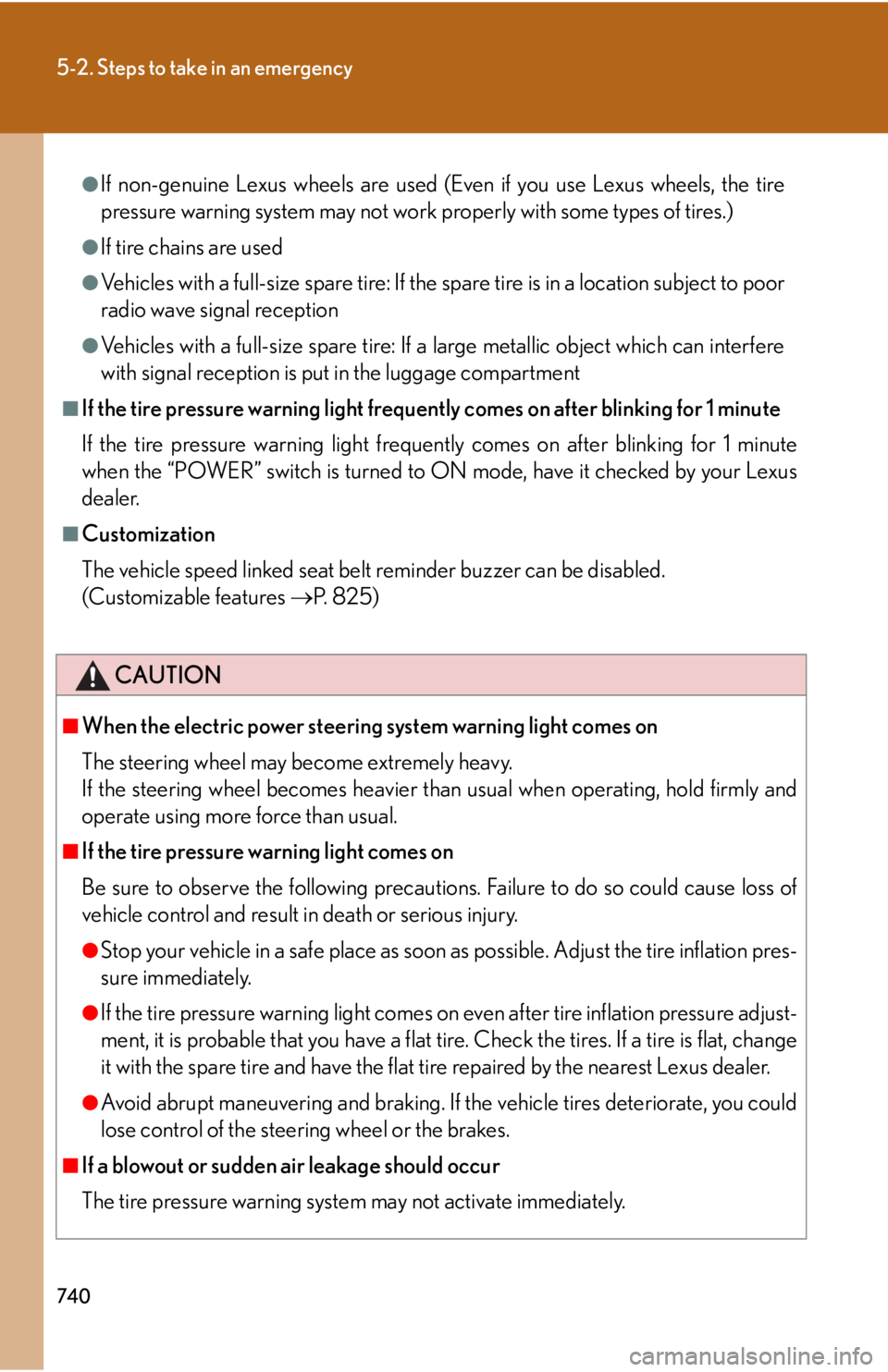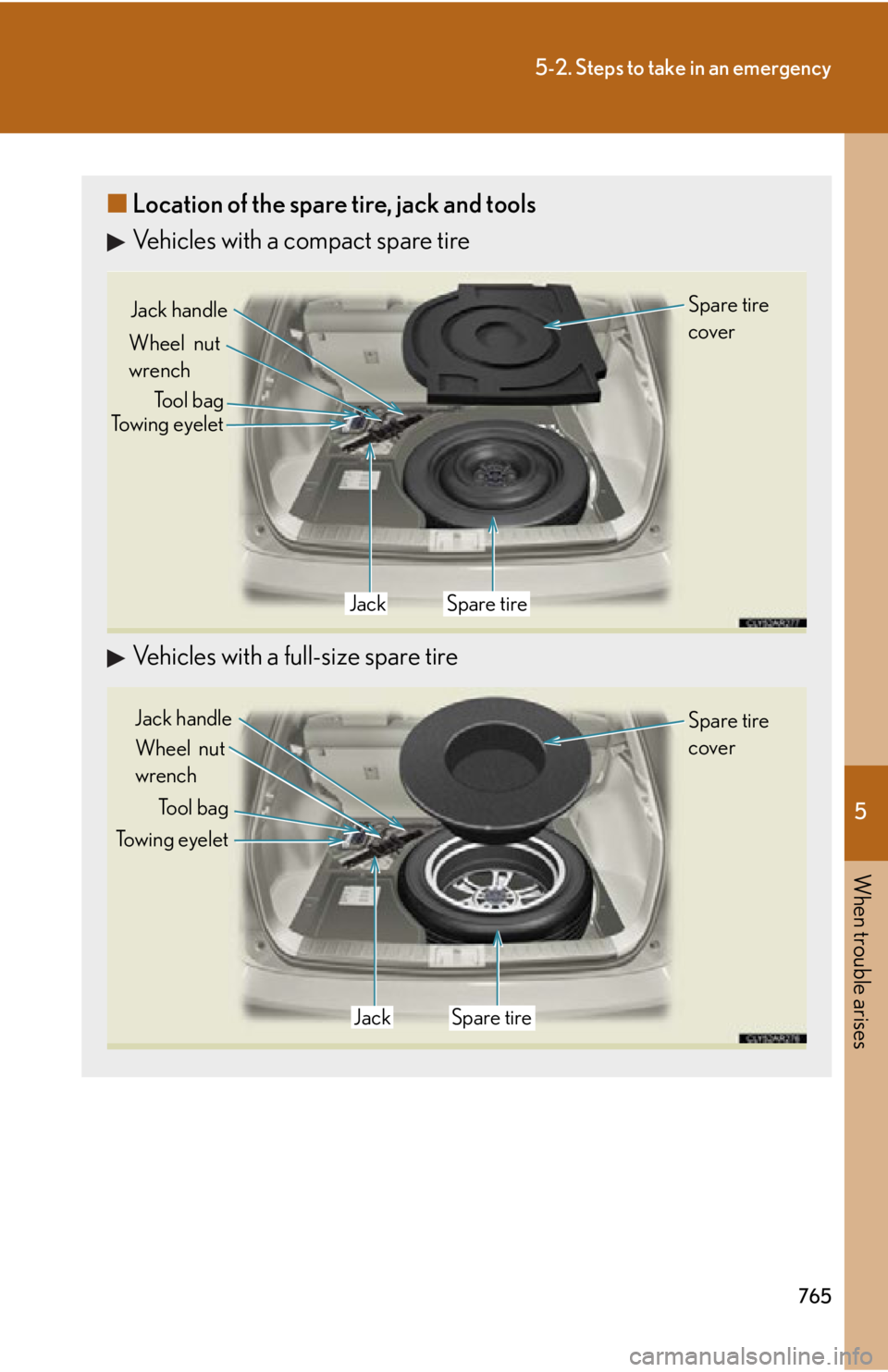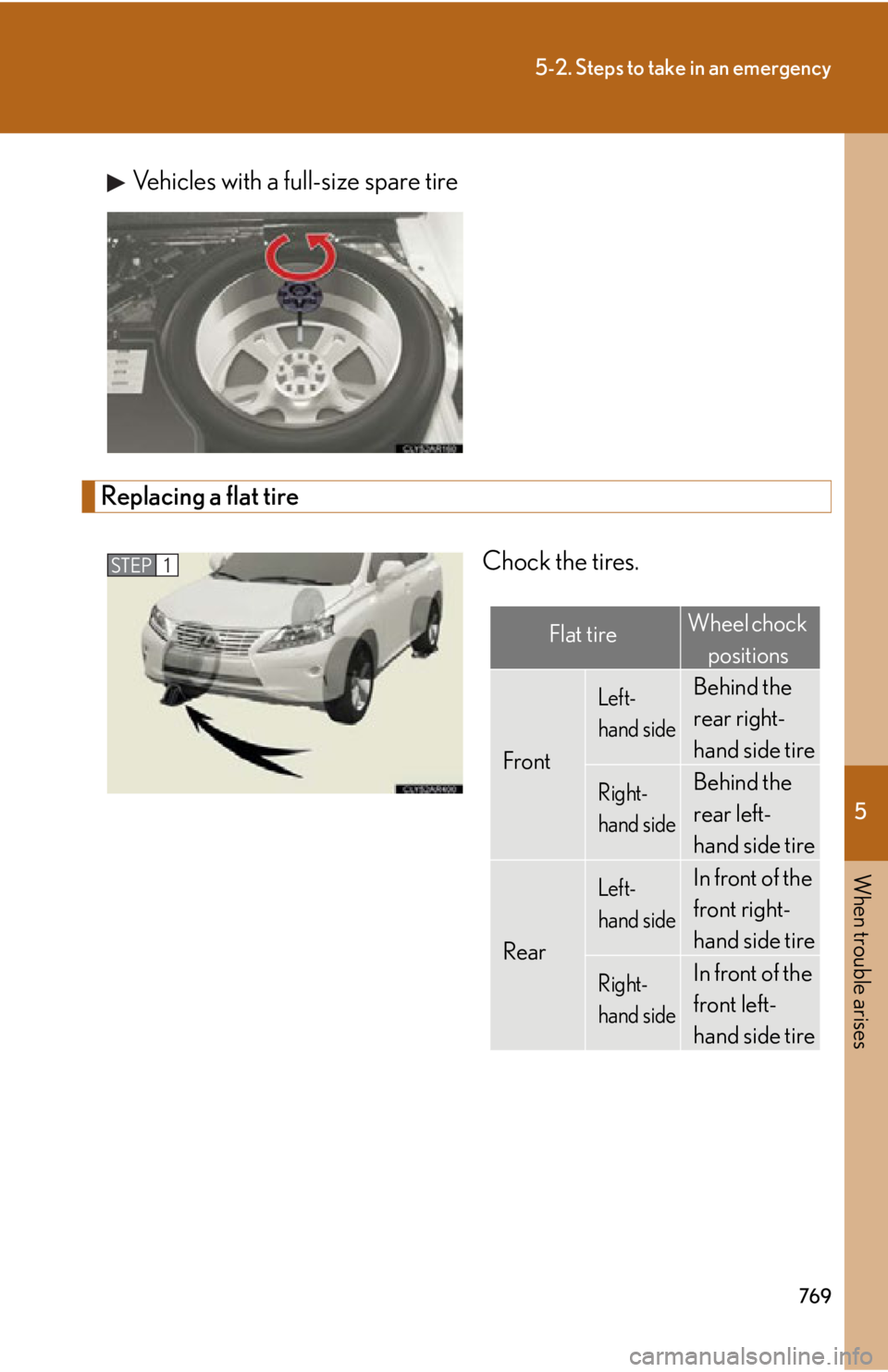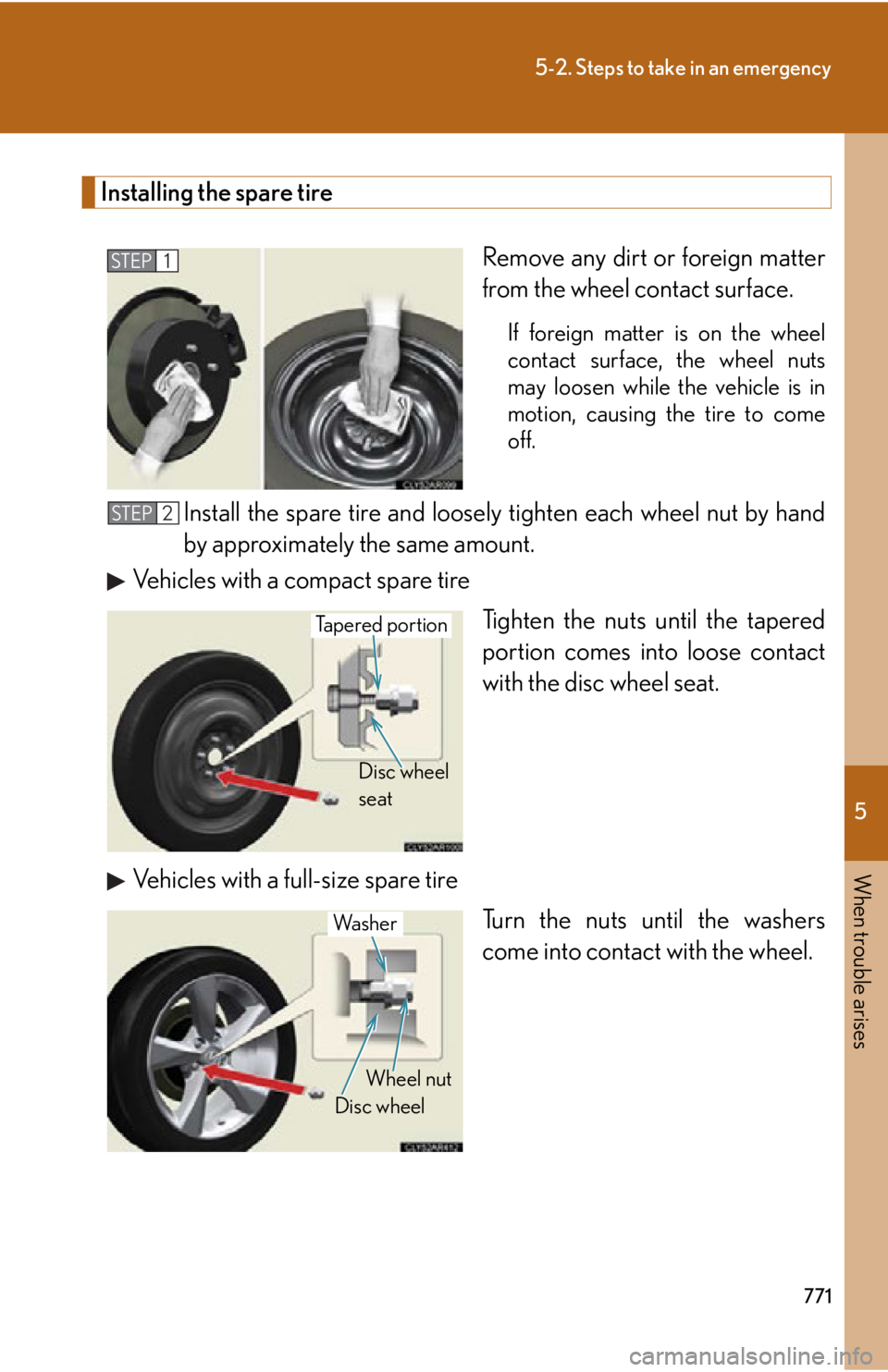2015 LEXUS RX450h spare wheel
[x] Cancel search: spare wheelPage 740 of 878

5
When trouble arises
7395-2. Steps to take in an emergency
■
The tire pressure warning light may come on due to natural causes
The tire pressure warning light may come on due to natural causes such as natural
air leaks and tire inflation pressure chan ges caused by temperature. In this case,
adjusting the tire inflation pressure will turn off the warning light (after a few min-
utes).■
When a tire is replaced with a spare tire
Vehicles with a compact spare tire
The compact spare tire is not equipped with a tire pressure warning valve and trans-
mitter. If a tire goes flat, the tire pressure warning light will not turn off even though
the flat tire has been replaced with the spare tire. Replace the spare tire with the
repaired tire and adjust the tire inflatio n pressure. The tire pressure warning light
will go off after a few minutes.
Vehicles with a full-size spare tire
The spare tire is also equipped with the tire pressure warning valve and transmitter.
The tire pressure warning light will turn on if the tire inflation pressure of the spare
tire is low. If a tire goes flat, even though the flat tire is replaced with the spare tire,
the tire pressure warning light does not turn off. Replace the spare tire with the
repaired tire and adjust to the proper tire inflation pressure. The tire pressure warn-
ing light will turn off after a few minutes.■
If the tire pressure warning system is not functioning
The tire pressure warning system will be disabled in the following conditions:
(When the condition becomes normal, the system will work properly.) ●
If tires not equipped with tire pressure warning valves and transmitters are used●
If the ID code on the tire pressure warning valves and transmitters is not regis-
tered in the tire pressure warning computer●
If the tire inflation pressure is 73 psi (500 kPa, 5.1 kgf/cm 2
or bar) or higher
The tire pressure warning system may be disabled in the following conditions:
(When the condition becomes normal, the system will work properly.)
●
If electronic devices or facilities using similar radio wave frequencies are nearby
●
If a radio set at similar frequencies is in use in the vehicle
●
If a window tint that affects the radio wave signals is installed
●
If there is a lot of snow or ice on the vehicle, in particular around the wheels or
wheel housings
Page 741 of 878

7405-2. Steps to take in an emergency
●
If non-genuine Lexus wheels are used (Even if you use Lexus wheels, the tire
pressure warning system may not work properly with some types of tires.)●
If tire chains are used●
Vehicles with a full-size spare tire: If the spare tire is in a location subject to poor
radio wave signal reception●
Vehicles with a full-size spare tire: If a large metallic object which can interfere
with signal reception is pu t in the luggage compartment■
If the tire pressure warning light freque ntly comes on after blinking for 1 minute
If the tire pressure warning light frequently comes on after blinking for 1 minute
when the “POWER” switch is turned to ON mode, have it checked by your Lexus
dealer.■
Customization
The vehicle speed linked seat belt reminder buzzer can be disabled.
(Customizable features P. 825)
CAUTION■
When the electric power steering system warning light comes on
The steering wheel may become extremely heavy.
If the steering wheel becomes heavier than usual when operating, hold firmly and
operate using more force than usual.■
If the tire pressure warning light comes on
Be sure to observe the following precautions. Failure to do so could cause loss of
vehicle control and result in death or serious injury. ●
Stop your vehicle in a safe place as soon as possible. Adjust the tire inflation pres-
sure immediately.●
If the tire pressure warning light comes on even after tire inflation pressure adjust-
ment, it is probable that you have a flat tire. Check the tires. If a tire is flat, change
it with the spare tire and have the flat tire repaired by the nearest Lexus dealer.
●
Avoid abrupt maneuvering and braking. If the vehicle tires deteriorate, you could
lose control of the steering wheel or the brakes.
■
If a blowout or sudden air leakage should occur
The tire pressure warning system may not activate immediately.
Page 742 of 878

5
When trouble arises
7415-2. Steps to take in an emergency
CAUTION■
Maintenance of the tires
Each tire, including the spare (if provided ), should be checked monthly when cold
and inflated to the inflation pressure re commended by the vehicle manufacturer on
the vehicle placard or tire inflation pressure label (tire and load information label).
(If your vehicle has tires of a different size than the size indicated on the vehicle
placard or tire inflation pressure label [t ire and load information label], you should
determine the proper tire inflation pressure for those tires.)
As an added safety feature, your vehicl e has been equipped with a tire pressure
monitoring system (TPMS-tire pressure wa rning system) that illuminates a low tire
pressure telltale (tire pressure warning light) when one or more of your tires is sig-
nificantly under-inflated. Accordingly, when the low tire pressure telltale (tire pres-
sure warning light) illuminates, you should stop and check your tires as soon as
possible, and inflate them to the proper pressure. Driving on a significantly under-
inflated tire causes the tire to overheat an d can lead to tire failure. Under-inflation
also reduces fuel efficiency and tire tread life, and may affect the vehicle's handling
and stopping ability.
Please note that the TPMS (tire pressure warning system) is not a substitute for
proper tire maintenance, and it is the driver's responsibility to maintain correct tire
pressure, even if under-inflation has not reached the level to trigger illumination of
the TPMS low tire pressure telltale (tire pressure warning light).
Your vehicle has also been equipped with a TPMS (tire pressure warning system)
malfunction indicator to indicate when th e system is not operating properly. The
TPMS (tire pressure warning system) malf unction indicator is combined with the
low tire pressure telltale (tire pressure warning light). When the system detects a
malfunction, the telltale will flash for approximately one minute and then remain
continuously illuminated. This sequence will continue upon subsequent vehicle
start-ups as long as the malfunction exists . When the malfunction indicator is illumi-
nated, the system may not be able to detect or signal low tire pressure as intended.
TPMS (tire pressure warning system) malfunctions may occur for a variety of rea-
sons, including the installation of replacem ent or alternate tires or wheels on the
vehicle that prevent the TPMS (tire pressure warning system) from functioning
properly. Always check the TPMS (tire pressure warning system) malfunction tell-
tale after replacing one or more tires or wheels on your vehicle to ensure that the
replacement or alternate tires and wheels allow the TPMS (tire pressure warning
system) to continue to function properly.
Page 766 of 878

5
When trouble arises
7655-2. Steps to take in an emergency
■ Location of the spare tire, jack and tools
Vehicles with a compact spare tire
Vehicles with a full-size spare tire Towing eyelet Tool bagJack handle
Jack Spare tireWheel nut
wrench Spare tire
cover
Towing eyelet To o l b a gJack handle
Jack Spare tireWheel nut
wrench Spare tire
cover
Page 770 of 878

5
When trouble arises
7695-2. Steps to take in an emergency
Vehicles with a full-size spare tire
Replacing a flat tire
Chock the tires.STEP 1
Flat tire Wheel chock
positions
Front Left-
hand side Behind the
rear right-
hand side tire
Right-
hand side Behind the
rear left-
hand side tire
Rear Left-
hand side In front of the
front right-
hand side tire
Right-
hand side In front of the
front left-
hand side tire
Page 772 of 878

5
When trouble arises
7715-2. Steps to take in an emergency
Installing the spare tire
Remove any dirt or foreign matter
from the wheel contact surface. If foreign matter is on the wheel
contact surface, the wheel nuts
may loosen while the vehicle is in
motion, causing the tire to come
off.
Install the spare tire and loosel y tighten each wheel nut by hand
by approximately the same amount.
Vehicles with a compact spare tire
Tighten the nuts until the tapered
portion comes into loose contact
with the disc wheel seat.
Vehicles with a full-size spare tire
Turn the nuts until the washers
come into contact with the wheel.STEP 1
STEP 2
Disc wheel
seatTapered portion
Wheel nut
Disc wheelWa s h e r
Page 773 of 878

7725-2. Steps to take in an emergency
Lower the vehicle.
Firmly tighten each wheel nut two
or three times in the order shown
in the illustration. Tightening torque:
76 ft•lbf (103 N•m, 10.5 kgf•m)
Stow the flat tire, tire jack and all tools.STEP 3
STEP 4
■
The compact spare tire ●
The compact spare tire is identified by the label “TEMPORARY USE ONLY”
on the tire sidewall.
Use the compact spare tire temporarily, and only in an emergency.●
Make sure to check the tire inflatio n pressure of the compact spare tire.
( P. 8 0 7 )■
When using the compact spare tire
As the compact spare tire is not equipped with a tire pressure warning valve and
transmitter, low inflation pressure of the spare tire will not be indicated by the tire
pressure warning system. Also, if you repl ace the compact spare tire after the tire
pressure warning light comes on, the light remains on. STEP 5
Page 774 of 878

5
When trouble arises
7735-2. Steps to take in an emergency
■
If you have a flat front tire on a road covered with snow or ice (vehicles with a
compact spare tire)
Install the compact spare tire on one of the rear wheels of the vehicle. Perform the
following steps and fit tire chains to the front tires:
Replace a rear tire with the compact spare tire.
Replace the flat front tire with the tire removed from the rear of the vehi-
cle.
Fit tire chains to the front tires.■
After completing the tire change
The tire pressure warning system must be reset. ( P. 6 7 1 )
CAUTION■
Using the tire jack
Improper use of the tire jack may cause the vehicle to suddenly fall off the jack,
leading to death or serious injury. ●
Do not use the tire jack for any purpose other than replacing tires or installing and
removing tire chains.●
Only use the tire jack that comes with this vehicle for replacing a flat tire.
Do not use it on other vehicles, and do no t use other tire jacks for replacing tires
on this vehicle.●
Always check that the tire jack is securely set to the jack point.●
Do not put any part of your body under the vehicle while it is supported by the
jack.●
Do not start or run the hybrid system while your vehicle is supported by the jack.●
Do not raise the vehicle while someone is inside.●
When raising the vehicle, do not put an object on or under the jack.
●
Do not raise the vehicle to a height greate r than that required to replace the tire.
●
Use a jack stand if it is necessary to get under the vehicle.
Take particular care when lowering the vehicle to ensure that no one working on or
near the vehicle may be injured. STEP 1
STEP 2
STEP 3